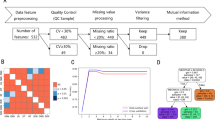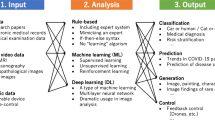Abstract
Continuous glucose monitoring (CGM) data analysis will provide a new perspective to analyze factors related to diabetic retinopathy (DR). However, the problem of visualizing CGM data and automatically predicting the incidence of DR from CGM is still controversial. Here, we explored the feasibility of using CGM profiles to predict DR in type 2 diabetes (T2D) by deep learning approach. This study fused deep learning with a regularized nomogram to construct a novel deep learning nomogram from CGM profiles to identify patients at high risk of DR. Specifically, a deep learning network was employed to mine the nonlinear relationship between CGM profiles and DR. Moreover, a novel nomogram combining CGM deep factors with basic information was established to score the patients’ DR risk. This dataset consists of 788 patients belonging to two cohorts: 494 in the training cohort and 294 in the testing cohort. The area under the curve (AUC) values of our deep learning nomogram were 0.82 and 0.80 in the training cohort and testing cohort, respectively. By incorporating basic clinical factors, the deep learning nomogram achieved an AUC of 0.86 in the training cohort and 0.85 in the testing cohort. The calibration plot and decision curve showed that the deep learning nomogram had the potential for clinical application. This analysis method of CGM profiles can be extended to other diabetic complications by further investigation.







Similar content being viewed by others
Data availability
The data that support the studying are not publicly available due to privacy or ethical restrictions.
References
Aiello L (1998) Diabetic retinopathy (technical review). Diabetes Care 21(1):143–156
Frederick L, Macular E (1984) A complication diabetic retinopathy. Survey of Ophthalmol 28:452–461. https://doi.org/10.1016/0039-6257(84)90227-3
Yau JWY, Rogers SL, Kawasaki R et al (2012) Global prevalence and major risk factors of diabetic retinopathy. Diabetes Care 35(3):556–564
Hendarto H, Pramono A, Saksono D et al (2016) The relationship of glycemic exposure (HbAlc) to the risk of subclinical hypothyroidism in type 2 diabetes mellitus patients. Diabetes Res Clin Pract 120(1):S204–S204
Mohamed Q, Gillies MC, Wong TY (2007) Management of diabetic retinopathy: a systematic review. JAMA 298(1):902–916
Pei X, Yao X, Yang Y et al (2022) Efficacy of artificial intelligence-based screening for diabetic retinopathy in type 2 diabetes mellitus patients. Diabetes Res Clin Pract 184:109190
Maistry A, Pillay A, Jembere E (2020) (2020) Improving the accuracy of diabetes retinopathy image classification using augmentation. Conference of the South African Institute of Computer Scientists and Information Technologists 1:134–140
Shin KH, Chi MJ (2009) Fundus examination rate in diabetics and the public health factors associated with fundus examination rate. J Korean Ophthalmol Soc 50(1):1319
Abràmoff MD, Niemeijer M, Suttorp-Schulten MSA et al (2008) Evaluation of a system for automatic detection of diabetic retinopathy from color fundus photographs in a large population of patients with diabetes. Diabetes Care 31:193–198
Bolinder J, Antuna R, Geelhoed-Duijvestijn P et al (2016) Novel glucose-sensing technology and hypoglycaemia in type 1 diabetes: a multicentre, non-masked, randomised controlled trial. The Lancet 388(10057):2254–2263
Li L, Sun J, Liemin R et al (2021) Time-series analysis of continuous glucose monitoring data to predict treatment efficacy in patients with T2DM. J Clin Endocrinol Metab 8(8):1–18
Zahedani AD, Torbaghan SS, Rahili S et al (2021) Improvement in glucose regulation using a digital tracker and continuous glucose monitoring in healthy adults and those with type 2 diabetes. Diabetes Therapy 1:1–16
Tao R, Yu X, Lu J et al (2021) Multilevel clustering approach driven by continuous glucose monitoring data for further classification of type 2 diabetes. BMJ Open Diabetes Res Care 9(1):e001869
Yu X, Ma N, Yang T et al (2021) A multi-level hypoglycemia early alarm system based on sequence pattern mining. BMC Med Inform Decis Mak 21(1):1–11
Sartore G, Chilelli NC, Burlina S et al (2013) Association between glucose variability as assessed by continuous glucose monitoring (CGM) and diabetic retinopathy in type 1 and type 2 diabetes. Acta Diabetol 50(1):437–442
Lu J, Ma X, Zhou J et al (2018) Association of time in range, as assessed by continuous glucose monitoring, with diabetic retinopathy in type 2 diabetes. Diabetes Care 41(11):2370–2376
Hirsch IB (2015) Glycemic variability and diabetes complications: does it matter? of course it does! Diabetes Care 38(8):1610–1614
De Nicolao G, Magni L, Dalla Man C et al (2011) Modeling and control of diabetes: towards the artificial pancreas. IFAC Proceedings Volumes 44(1):7092–7101
Fox KAA, FitzGerald G, Puymirat E et al (2014) Should patients with acute coronary disease be stratified for management according to their risk? Derivation, external validation and outcomes using the updated GRACE risk score. BMJ Open 4(2):e004425
Sperandei S (2014) Understanding logistic regression analysis. Biochemia medica 24(1):12–18
Legge BJ, Banister EW (1986) The Astrand-Ryhming nomogram revisited. J Appl Physiol 61(3):1203–1209
Goodfellow I, Bengio Y, Courville A (2016) Deep learning. MIT press, Cambridge
Carin L, Pencina MJ (2018) On deep learning for medical image analysis. JAMA 320(11):1192–1193
Katzman JL, Shaham U, Cloninger A et al (2018) DeepSurv: personalized treatment recommender system using a Cox proportional hazards deep neural network. BMC Med Res Methodol 18(1):1–12
Cai W, He B, Hu M et al (2019) A radiomics-based nomogram for the preoperative prediction of posthepatectomy liver failure in patients with hepatocellular carcinoma. Surg Oncol 28:78–85
Caliendo M, Kopeinig S (2008) Some practical guidance for the implementation of propensity score matching. Journal of economic surveys 22(1):31–72
Randolph JJ, Falbe K (2014) A step-by-step guide to propensity score matching in R. Pract Assess Res Eval 19(18):6
Prenter PM (2008) Splines and variational methods. Dover Publicatio, New York
Flaxel CJ, Adelman RA, Bailey ST et al (2020) Diabetic retinopathy preferred practice pattern. Ophthalmology 127(1):P66–P145
J. Z. WeIPing J, Yuqian B. (2019) Continuous glucose monitoring. Shanghai Science and Technology Pass, Shanghai.
Remeseiro B, Bolon-Canedo V (2019) A review of feature selection methods in medical applications. Comput Biol Med 112:103375
Raj RJS, Shobana SJ, Pustokhina IV et al (2020) Optimal feature selection-based medical image classification using deep learning model in internet of medical things. IEEE Access 8:58006–58017
Roth V (2004) The generalized LASSO. IEEE Trans Neural Networks 15(1):16–28
Jiang C, Kong Z, Liu S et al (2019) Fusion radiomics features from conventional MRI predict MGMT promoter methylation status in lower grade gliomas. Eur J Radiol 121:108714
Huang Y, Li H, Yu X (2021) A multiview feature fusion model for heartbeat classification. Physiol Meas 42(6):065003
Seo JH, Kim HJ, Lee JY (2020) Nomogram construction to predict dyslipidemia based on a logistic regression analysis. J Appl Stat 47(5):914–926
Zhou XH, Higgs RE (1998) COMPROC and CHECKNORM: computer programs for comparing accuracies of diagnostic tests using ROC curves in the presence of verification bias. Comput Methods Programs Biomed 57(3):179–186
Obuchowski N A, Bullen J A. (2018) Receiver operating characteristic (ROC) curves: review of methods with applications in diagnostic medicine. Physics in Medicine & Biology 63(7): 07TR01.
Osterhoudt H W, Ray Jr L N. (1967) Gel permeation chromatography: On the shape of the calibration plot and molecular size separability. Journal of Polymer Science Part A‐2: Polymer Physics 5(3): 569–581.
Bailey R (2019) The relationship between continuous glucose monitor (CGM) derived metrics and indices of glycemic control. University of South Florida, South Florida
Ogunyemi O, Kermah D (2015) Machine learning approaches for detecting diabetic retinopathy from clinical and public health records. AMIA Ann Symp Proc 11:983–990
Wang R, Miao Z, Liu T, Liu M, Grdinovac K, Song X, Liang Y, Delen D, Paiva W (2021) Derivation and validation of essential predictors and risk index for early detection of diabetic retinopathy using electronic health records. J Clin Med. https://doi.org/10.3390/jcm10071473
Esfahani MT, Ghaderi M, Kafiyeh R (2018) Classification of diabetic and normal fundus images using new deep learning method. Leonardo Electron J Pract Technol 17(32):233–248
Quellec G, Charriere K, Boudi Y, Cochener B, Lamard M (2017) Deep image mining for diabetic retinopathy screening. Med Image Anal 39:178–193
Rashid MM, Askari MR, Chen C et al (2022) Artificial intelligence algorithms for treatment of diabetes. Algorithms 15(9):299
Askari MR et al (2022) Detection and classification of unannounced physical activities and acute psychological stress events for interventions in diabetes treatment. Algorithms 15(10):352
Acknowledgements
We would like to thank all the involved clinicians, nurses, and technicians at Shanghai Clinical Center for Diabetes for dedicating their time and skills to the completion of this study. The authors would like to thank to the editors and anonymous reviewers for their constructive comments and suggestions that have imporved the quality of the study.
Funding
This work was supported by the National Key R&D Program of China [2018YFC2001004]; National Natural Science Foundation of China Youth Fund Project [61903071]; National Natural Science Foundation of China [61973067] and the Shanghai Municipal Education Commission-Gaofeng Clinical Medicine Grant Support [20161430].
Author information
Authors and Affiliations
Contributions
RT and XY designed the algorithm, analyzed data and wrote the paper. JZ, JL, XY and HL conceived the study and revised the manuscript. JL, WL and YW conducted the study and collected data. YW and ZZ analyzed data. XY, JZ and HL are the guarantors of this work. All authors read and approved the final manuscript.
Corresponding author
Ethics declarations
Conflict of interest
The authors declare no conflict of interest relevant to this work.
Ethical approval
Research Ethics Committees of Shanghai Jiao Tong University School of Medicine Affiliated Sixth People’s Hospital (Date 2017-04-27/No.2017-047).
Consent to participate
Informed consent was obtained from individual participants included in the study.
Consent to publication
Patients signed informed consent regarding publishing their data.
Additional information
Publisher's Note
Springer Nature remains neutral with regard to jurisdictional claims in published maps and institutional affiliations.
Supplementary Information
Below is the link to the electronic supplementary material.
Rights and permissions
Springer Nature or its licensor (e.g. a society or other partner) holds exclusive rights to this article under a publishing agreement with the author(s) or other rightsholder(s); author self-archiving of the accepted manuscript version of this article is solely governed by the terms of such publishing agreement and applicable law.
About this article
Cite this article
Tao, R., Yu, X., Lu, J. et al. A deep learning nomogram of continuous glucose monitoring data for the risk prediction of diabetic retinopathy in type 2 diabetes. Phys Eng Sci Med 46, 813–825 (2023). https://doi.org/10.1007/s13246-023-01254-3
Received:
Accepted:
Published:
Issue Date:
DOI: https://doi.org/10.1007/s13246-023-01254-3




